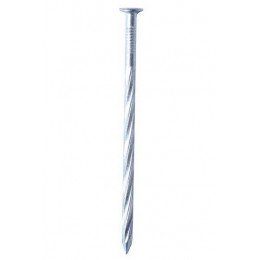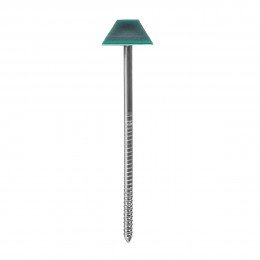Tile fastening to the roof base can be done by various methods. Although most products are equipped with an adhesive strip and are completed with mastic, additional fixation with driven fasteners will not be superfluous.
What type of hardware to use in a particular case depends largely on the material from which the solid flooring is made.However, the most convenient way is to nail it with special nails, which will perfectly attach the flexible material to plywood, OSB boards or solid wood battens.
Roofing nails differ from traditional ones with a large head and an annular notch on the shaft. The diameter of the head ranges from 8 to 12 mm, and the length starts from 25 mm and reaches 45 mm. The thickness of the leg is 2.5-3.4 mm. High-quality nails for shingles must be galvanized. A soft roof is in constant contact with moisture - if not with rain and snow, then with condensate. Thus, products with anti-corrosion coating will last much longer.
The fastening of shingles is carried out by driving nails with a classic hammer or with the help of modern pneumatic tools. Installation of flexible tiles must be carried out carefully, following the recommendations of the installation instructions. Fasteners should be oriented strictly perpendicular to the base. It is necessary to drive the hardware entirely to the tight adjacency to the tile sheet without a gap and also without leaving gaps that could lead to a breakthrough shingles. On such a principle mounted as ordinary material and accessories: valley carpet, ridges, cornices and so on.
The average consumption of nails for shingles is taken at a ratio of 8 kg per 100 m2 of roofing. The specified number provides for a traditional fixing when using 4 pcs / shingle. Accordingly, given that at steep slopes (> 45 degrees) is accepted to increase the number of fasteners to 6 pcs / m2, then to carry out roofing work should buy roofing nails proportionally 1.5




